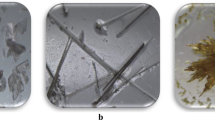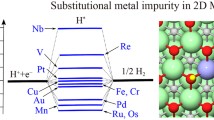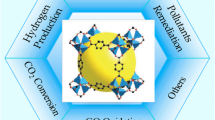Abstract
Context
The design and synthesis of new high energy density materials is an important part of the research in the field of high energy materials. However, the synthesis of high-energy materials is very difficult and dangerous. Therefore, it is necessary to design the compounds in advance and evaluate the performance of the designed compounds, so as to screen the high-energy candidate compounds with excellent performance and provide reference for future synthesis and application. 1,2,5-oxadiazole (furazan) and 1,2,4-oxadiazole are five-membered nitrogen-oxygen heterocycles. Because their structures contain high-energy N-O, C=N bonds, they can effectively improve the energy density and oxygen balance of compounds, which has attracted widespread attention. In this paper, 42 kinds of oxadiazole-bifurazan energetic derivatives were designed by inserting different functional groups and changing the parent bridging groups with 1,2,4-oxadiazole and furazan as the basic structural units. Their electronic structures, aromaticity, heats of formation (HOFs), detonation properties, thermodynamic properties and electrostatic potential were systematically studied by density functional than theory (DFT). The results show that -C (NO2)3 has the greatest improvement effect on HOFs among all the substituent groups. The detonation performance of -N=N- bridged oxadiazole-bifurazan derivatives is better than that of -NH-NH- bridged derivatives. And -C(NO2)3 is the most effective group to improve the detonation performance and density of compounds. Compared with the parent compounds, when a -C(NO2)3 was introduced, the density increased by about 5.5%. A6 (D = 10.30 km·s-1, P = 48.86 GPa) and D6 (D = 9.57 km·s-1, P = 42.31 GPa) are the compounds with the best D and P among the designed compounds, which are higher than RDX and HMX, and are potential candidates for new high-energy materials.
Methods
With the help of Gaussian16 software and Multiwfn 3.8 package, the B3LYP method in density functional theory was selected. The 6-311G (d, p) basis set was used to optimize the structure of the 42 derivatives, and the high-precision def2-TZVPP basis set was used to calculate the energy.











Similar content being viewed by others
Data availability
We confirm the availability of all the data and materials in this manuscript. The manuscript has full control of all primary data, and the authors agree to allow the journal to review their data if requested.
Code availability
N/A
References
Zhang C (2006) Computational investigation of the detonation properties of furazans and furoxans. J Mol Struct (THEOCHEM) 765:77–83. https://doi.org/10.1016/j.theochem.2006.03.007
Zhang R, Xu X, Ma P et al (2022) High-energy materials based on 1H-tetrazole and furoxan: Molecular design and screening. J Mol Struct 1250:131900. https://doi.org/10.1016/j.molstruc.2021.131900
Wu Q, Zhu W, Xiao H (2014) A new design strategy for high-energy low-sensitivity explosives: combining oxygen balance equal to zero, a combination of nitro and amino groups, and N-oxide in one molecule of 1-amino-5-nitrotetrazole-3N-oxide. J Mater Chem A 2:13006. https://doi.org/10.1039/C4TA01879F
Ma P, Pan Y, Jiang J, Zhu S (2018) Molecular Dynamic Simulation and Density Functional Theory Insight into the Nitrogen Rich explosive 1,5-diaminotetrazole (DAT). Procedia Eng 211:546–554. https://doi.org/10.1016/j.proeng.2017.12.047
Ali AN, Son SF, Hiskey MA, Naud DL (2004) Novel High Nitrogen Propellant Use in Solid Fuel Micropropulsion. J Propuls Power 20:120–126. https://doi.org/10.2514/1.9238
Wang Q, Shao Y, Lu M (2019) Azo1,3,4-oxadiazole as a Novel Building Block to Design High-Performance Energetic Materials. Cryst Growth Des 19:839–844. https://doi.org/10.1021/acs.cgd.8b01404
Talawar MB, Sivabalan R, Senthilkumar N et al (2004) Synthesis, characterization and thermal studies on furazan- and tetrazine-based high energy materials. J Hazard Mater 113:11–25. https://doi.org/10.1016/j.jhazmat.2004.05.016
Huang Y, Zhang Q, Zhan L-W et al (2020) Theoretical investigation of nitrogen-rich high-energy-density materials based on furazan substituted s-triazine. J Mol Model 26:175. https://doi.org/10.1007/s00894-020-04414-4
Wei H, He C, Zhang J, Shreeve JM (2015) Combination of 1,2,4-Oxadiazole and 1,2,5-Oxadiazole Moieties for the Generation of High-Performance Energetic Materials. Angew Chem Int Ed 54:9367–9371. https://doi.org/10.1002/anie.201503532
Ma J, Zhang G, Gu H et al (2019) Polynitro-1,2,4-triazole-functionalized azo-furazans as high-performance and insensitive energetic materials. New J Chem 43:8370–8375. https://doi.org/10.1039/c9nj01065c
Lu T, Chen F (2012) Multiwfn: A multifunctional wavefunction analyzer. J Comput Chem 33:580–592. https://doi.org/10.1002/jcc.22885
Chen ZX, Xiao JM, Xiao HM, Chiu YN (1999) Studies on heats of formation for tetrazole derivatives with density functional theory B3LYP method. J Phys Chem A 103:8062–8066. https://doi.org/10.1021/jp9903209
Ju XH, Wang X, Bei FL (2005) Substituent effects on heats of formation, group interactions, and detonation properties of polyazidocubanes. J Comput Chem 26:1263–1269. https://doi.org/10.1002/jcc.20263
Atkins PW (2022) Physical chemistry, second edition. J Chem Educ. https://pubs.acs.org/doi/abs/10.1021/ed060pA63.2
Politzer P, Ma Y, Lane P, Concha MC (2005) Computational prediction of standard gas, liquid, and solid-phase heats of formation and heats of vaporization and sublimation. Int J Quantum Chem 105:341–347. https://doi.org/10.1002/qua.20709
Qiu L, Xiao H, Gong X et al (2007) Crystal density predictions for nitramines based on quantum chemistry. J Hazard Mater 141:280–288. https://doi.org/10.1016/j.jhazmat.2006.06.135
Politzer P, Martinez J, Murray JS et al (2009) An electrostatic interaction correction for improved crystal density prediction. Mol Phys 107:2095–2101. https://doi.org/10.1080/00268970903156306
Kamlet MJ, Jacobs SJ (1968) Chemistry of Detonations. I. A Simple Method for Calculating Detonation Properties of C–H–N–O Explosives. J Chem Phys 48:23–35. https://doi.org/10.1063/1.1667908
Hao L, Wang J, Zhai D et al (2020) Theoretical Study on CL-20-Based Cocrystal Energetic Compounds in an External Electric Field. ACS Omega 5:14767–14775. https://doi.org/10.1021/acsomega.0c01643
He P, Zhang J-G, Wu L et al (2017) Computational design and screening of promising energetic materials: Novel azobis (tetrazoles) with ten catenated nitrogen atoms chain. J Phys Org Chem 30:e3674. https://doi.org/10.1002/poc.3674
Klod S, Kleinpeter E (2001) Ab initio calculation of the anisotropy effect of multiple bonds and the ring current effect of arenes—application in conformational and configurational analysis. J Chem Soc Perkin Trans 2:1893–1898. https://doi.org/10.1039/B009809O
Gutowski KE, Rogers RD, Dixon DA (2007) Accurate Thermochemical Properties for Energetic Materials Applications. II. Heats of Formation of Imidazolium-, 1,2,4-Triazolium-, and Tetrazolium-Based Energetic Salts from Isodesmic and Lattice Energy Calculations. J Phys Chem B 111:4788–4800. https://doi.org/10.1021/jp066420d
Miroshnichenko EA, Kon’kova TS, Yun M (2003) Thermochemistry of Primary Nitramines. Dokl Phys Chem 392:253–255. https://doi.org/10.1023/A:1026182227885
Zhai D, Wang J, Hao L et al (2019) Molecular design and properties of bridged energetic pyridines derivatives. RSC Adv 9:37747–37758. https://doi.org/10.1039/C9RA07087G
Xia W, Zhang R, Xu X et al (2021) Theoretical studies of novel high energy density materials based on oxadiazoles. J Mol Model 27:204. https://doi.org/10.1007/s00894-021-04805-1
Hao L, Liu X, Zhai D et al (2020) Theoretical Studies on the Performance of HMX with Different Energetic Groups. ACS Omega 5:29922–29934. https://doi.org/10.1021/acsomega.0c04237
Politzer P, Murray JS (2021) Oxatriazoles: Potential Frameworks for Energetic Compounds? Propellants Explos Pyrotech 46:222–232. https://doi.org/10.1002/prep.202000243
Fei T, Du Y, He C, Pang S (2018) Theoretical investigations on azole-fused tricyclic 1,2,3,4-tetrazine-2-oxides. RSC Adv 8:27235–27245. https://doi.org/10.1039/c8ra05274c
Thangadurai S, Kartha KPS, Sharma DR, Shukla SK (2004) Review of some newly synthesized high energetic materials. Sci Technol Energ Mater 65:215–226
Politzer P, Murray JS (2016) High Performance, Low Sensitivity: Conflicting or Compatible? Propellants Explos Pyrotech 41:414–425. https://doi.org/10.1002/prep.201500349
Politzer P, Murray JS (2011) Some Perspectives on Estimating Detonation Properties of C, H, N, O Compounds. Cent Eur J Energ Mater 8:209–220
Xie Z, Hu S, Cao X (2016) Theoretical insight into the influence of molecular ratio on the binding energy and mechanical property of HMX/2-picoline-N-oxide cocrystal, cooperativity effect and surface electrostatic potential. Mol Phys 114:2164–2176. https://doi.org/10.1080/00268976.2016.1190038
Murray JS, Politzer P (1988) Calculated structures and electrostatic potentials of some 1,4-dioxazines and 1,4-dioxadiazines. J Mol Struct (THEOCHEM) 180:161–173. https://doi.org/10.1016/0166-1280(88)80087-3
Funding
This study was supported by the Natural Science Foundation of Jiangsu Province (NO. BK20220352). We are so grateful to the High Performance Computing Center of Nanjing Tech University for doing the numerical calculations in this paper on its x-Flex enterprise blade cluster system.
Author information
Authors and Affiliations
Contributions
The manuscript was written through the contributions of all authors. Jun Chen: software, data curation, writing original draft. Jiani Xu and Tingting Xiao: formal analysis. Meihua Zhao and Jun Cao: investigation, validation. Peng Ma: resources, project administration. Congming Ma: conceptualization, methodology.
Corresponding author
Ethics declarations
Ethics approval
We allow the journal to review all the data, and we confirm the validity of theresults. There are no financial relationships. This work was not published previously, and it is not submitted to more than one journal. It is also not split up into several parts to submit. No data have been fabricated or manipulated.
Consent to participate
All the authors agree to participate in this investigation.
Consent for publication
All the authors agree to publish the manuscript.
Conflict of interest
These authors declare no competing interests.
Additional information
Publisher’s note
Springer Nature remains neutral with regard to jurisdictional claims in published maps and institutional affiliations.
Supplementary information
Rights and permissions
Springer Nature or its licensor (e.g. a society or other partner) holds exclusive rights to this article under a publishing agreement with the author(s) or other rightsholder(s); author self-archiving of the accepted manuscript version of this article is solely governed by the terms of such publishing agreement and applicable law.
About this article
Cite this article
Chen, J., Xu, J., Xiao, T. et al. Molecular design and theoretical study of oxadiazole-bifurazan derivatives. J Mol Model 29, 175 (2023). https://doi.org/10.1007/s00894-023-05571-y
Received:
Accepted:
Published:
DOI: https://doi.org/10.1007/s00894-023-05571-y




